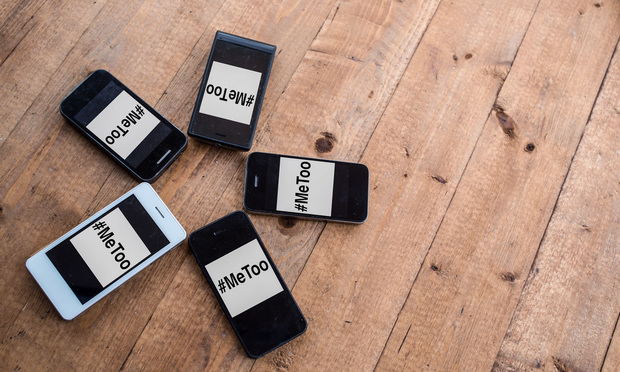A Company's #MeToo Moment
The #MeToo movement has empowered victims of harassment in ways never before thought possible, exposing the “open secrets” of serial abusers and…
April 01, 2018 at 12:00 AM
5 minute read
 Credit: Filip Jedraszak/Shutterstock.com
Credit: Filip Jedraszak/Shutterstock.com
The #MeToo movement has empowered victims of harassment in ways never before thought possible, exposing the “open secrets” of serial abusers and prompting a rethinking of interactions both inside and outside of the workplace.
But that empowerment has brought new challenges for companies responding to public allegations of wrongdoing by their employees.
The immediate impact of a viral hashtag can tempt employees to skip traditional reporting mechanisms and seek instant justice by naming the perpetrator and the company through social media. No company wants to first learn of an employee's allegation only after it starts trending on Twitter.
How can a company address harassment complaints fairly and effectively when they are launched with a tweet and a hashtag?
A Company's #MeToo Moment
Imagine the following scenario. HR Manager is nervously approached by an employee. The employee shows HR Manager a post made by Jane Doe, another Company employee, on social media the previous evening:
I'm so done with my boss. #MeToo
HR Manager is familiar with the #MeToo tag and has an idea of what the post means. HR Manager is also taken by surprise. The Company has a comprehensive anti-harassment policy in place, which provides employees multiple avenues to report sexual-harassment. But Jane Doe has not used any of the Company's reporting mechanisms. HR Manager immediately alerts the Company to the post. What should the Company do next?
The Company could take the position that the post does not suggest harassment and, therefore, the Company has no duty to investigate. After all, Jane Doe has not made a formal complaint. But this poses risks. First, as #MeToo becomes increasingly ubiquitous, the Company may have trouble saying that it did not know Jane Doe was referencing sexual harassment. And second, the clock is ticking on the post going viral. If the post is spread by a social media activist or news outlets, the chance to discreetly address the issue is gone. To make matters worse, if the Company does not quickly respond, the narrative may be that the Company was either indifferent to harassment or actively tried to cover it up. If that story gains traction, regardless of the merits of Jane Doe's complaint, it could significantly damage the Company's reputation.
Knowing these risks, the Company should reach out to Jane Doe soon after learning of her post. It should tell Jane Doe that it saw her post and takes any complaint about harassment very seriously. The Company should ask Jane Doe why she made the social media post. If she says there was no harassment, then the Company should remind her of the policies for making a harassment complaint. If she says she was harassed, the Company should investigate as it would for any other harassment complaint.
Formulating the right response to a #MeToo post depends on the nature of the post itself. If it directly alleges sexual harassment, e.g. “my boss touched me inappropriately,” the Company must investigate. A post directed at the Company's social media handle (“I'm so done with @Company #MeToo”) further blurs the line of whether the employee made a complaint to the Company. What if one employee posts on social media about the sexual harassment of another employee? The Company should separately interview the employee who made the post and the employee who was the subject of the post.
The Company might wish to ask an employee to delete a #MeToo social media post. But that raises other concerns. The Company could risk violating the NLRA by asking the employee to delete the post. It could also be used as evidence of retaliation under Title VII. More practically, telling an employee to take down the social media post could evoke the Streisand Effect—inadvertently encouraging the spread of the post by broadcasting that the Company sought to suppress it.
Reducing Risk in the #MeToo Era
There are several steps a company can take to reduce risk and prepare itself in the #MeToo era. Companies need to consider the following approaches:
- Review anti-harassment policies. The policy should reflect a clear commitment to preventing any harassment in the workplace. And the company should have multiple avenues for an employee to report harassment.
- Train employees and managers. This training should cover what constitutes harassment and how to report it. Managers should be trained on how to respond if a complaint is brought to them. Companies should also explain to employees that posting on social media is not a substitute for the company's reporting procedures.
- Develop a strategy in advance for addressing a #MeToo post. Because of the speed at which a #MeToo post can spread through social media, companies should not try to craft a strategy on the fly during a crisis.
- Watch out for retaliation. Once an employee has made a #MeToo post, it could be considered protected activity under Title VII. Companies should be careful to prevent retaliation against the employee making the post. Claims of retaliation are often easier to prove than the underlying claim of harassment.
Responding to a #MeToo social media post can have serious legal and public relations consequences. The movement has not yet changed the laws prohibiting sexual harassment in the workplace. However, it has accelerated the time frame in which companies need to address an accusation of harassment. Now, more than ever, a company must be prepared for its own #MeToo moment.
Adam Sencenbaugh is a partner in the firm's Austin office. Henson Adams is an associate in the firm's San Antonio office.
This content has been archived. It is available through our partners, LexisNexis® and Bloomberg Law.
To view this content, please continue to their sites.
Not a Lexis Subscriber?
Subscribe Now
Not a Bloomberg Law Subscriber?
Subscribe Now
NOT FOR REPRINT
© 2025 ALM Global, LLC, All Rights Reserved. Request academic re-use from www.copyright.com. All other uses, submit a request to [email protected]. For more information visit Asset & Logo Licensing.
You Might Like
View All

Nondisparagement Clauses in Divorce: Balancing Family Harmony and Free Speech
6 minute read

Trending Stories
- 1No Two Wildfires Alike: Lawyers Take Different Legal Strategies in California
- 2Poop-Themed Dog Toy OK as Parody, but Still Tarnished Jack Daniel’s Brand, Court Says
- 3Meet the New President of NY's Association of Trial Court Jurists
- 4Lawyers' Phones Are Ringing: What Should Employers Do If ICE Raids Their Business?
- 5Freshfields Hires Ex-SEC Corporate Finance Director in Silicon Valley
Who Got The Work
J. Brugh Lower of Gibbons has entered an appearance for industrial equipment supplier Devco Corporation in a pending trademark infringement lawsuit. The suit, accusing the defendant of selling knock-off Graco products, was filed Dec. 18 in New Jersey District Court by Rivkin Radler on behalf of Graco Inc. and Graco Minnesota. The case, assigned to U.S. District Judge Zahid N. Quraishi, is 3:24-cv-11294, Graco Inc. et al v. Devco Corporation.
Who Got The Work
Rebecca Maller-Stein and Kent A. Yalowitz of Arnold & Porter Kaye Scholer have entered their appearances for Hanaco Venture Capital and its executives, Lior Prosor and David Frankel, in a pending securities lawsuit. The action, filed on Dec. 24 in New York Southern District Court by Zell, Aron & Co. on behalf of Goldeneye Advisors, accuses the defendants of negligently and fraudulently managing the plaintiff's $1 million investment. The case, assigned to U.S. District Judge Vernon S. Broderick, is 1:24-cv-09918, Goldeneye Advisors, LLC v. Hanaco Venture Capital, Ltd. et al.
Who Got The Work
Attorneys from A&O Shearman has stepped in as defense counsel for Toronto-Dominion Bank and other defendants in a pending securities class action. The suit, filed Dec. 11 in New York Southern District Court by Bleichmar Fonti & Auld, accuses the defendants of concealing the bank's 'pervasive' deficiencies in regards to its compliance with the Bank Secrecy Act and the quality of its anti-money laundering controls. The case, assigned to U.S. District Judge Arun Subramanian, is 1:24-cv-09445, Gonzalez v. The Toronto-Dominion Bank et al.
Who Got The Work
Crown Castle International, a Pennsylvania company providing shared communications infrastructure, has turned to Luke D. Wolf of Gordon Rees Scully Mansukhani to fend off a pending breach-of-contract lawsuit. The court action, filed Nov. 25 in Michigan Eastern District Court by Hooper Hathaway PC on behalf of The Town Residences LLC, accuses Crown Castle of failing to transfer approximately $30,000 in utility payments from T-Mobile in breach of a roof-top lease and assignment agreement. The case, assigned to U.S. District Judge Susan K. Declercq, is 2:24-cv-13131, The Town Residences LLC v. T-Mobile US, Inc. et al.
Who Got The Work
Wilfred P. Coronato and Daniel M. Schwartz of McCarter & English have stepped in as defense counsel to Electrolux Home Products Inc. in a pending product liability lawsuit. The court action, filed Nov. 26 in New York Eastern District Court by Poulos Lopiccolo PC and Nagel Rice LLP on behalf of David Stern, alleges that the defendant's refrigerators’ drawers and shelving repeatedly break and fall apart within months after purchase. The case, assigned to U.S. District Judge Joan M. Azrack, is 2:24-cv-08204, Stern v. Electrolux Home Products, Inc.
Featured Firms
Law Offices of Gary Martin Hays & Associates, P.C.
(470) 294-1674
Law Offices of Mark E. Salomone
(857) 444-6468
Smith & Hassler
(713) 739-1250






